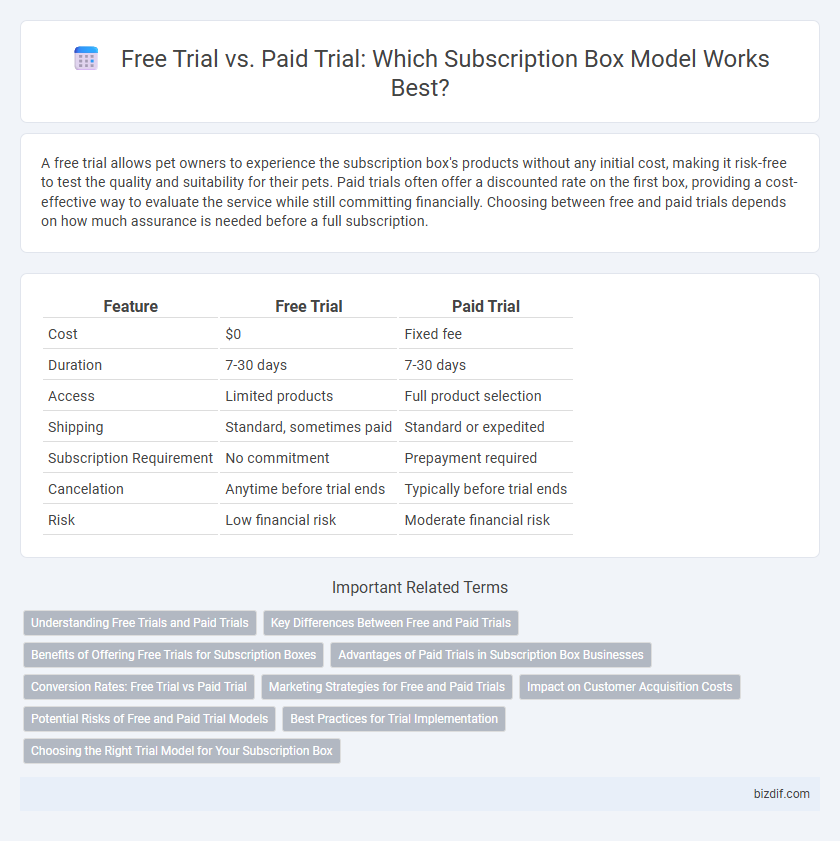A free trial allows pet owners to experience the subscription box's products without any initial cost, making it risk-free to test the quality and suitability for their pets. Paid trials often offer a discounted rate on the first box, providing a cost-effective way to evaluate the service while still committing financially. Choosing between free and paid trials depends on how much assurance is needed before a full subscription.
Table of Comparison
| Feature | Free Trial | Paid Trial |
|---|---|---|
| Cost | $0 | Fixed fee |
| Duration | 7-30 days | 7-30 days |
| Access | Limited products | Full product selection |
| Shipping | Standard, sometimes paid | Standard or expedited |
| Subscription Requirement | No commitment | Prepayment required |
| Cancelation | Anytime before trial ends | Typically before trial ends |
| Risk | Low financial risk | Moderate financial risk |
Understanding Free Trials and Paid Trials
Free trials allow subscribers to experience a subscription box at no cost for a limited time, enabling evaluation of product quality and service before committing financially. Paid trials require upfront payment but often offer a discounted rate for the trial period, providing access to full subscription benefits and exclusive items. Understanding the differences between free and paid trials helps consumers assess value, risk, and the overall suitability of subscription box services.
Key Differences Between Free and Paid Trials
Free trials offer users temporary access to subscription boxes without upfront payment, allowing risk-free evaluation of product value and quality. Paid trials require an initial charge, usually discounted, to access the box but often include perks such as exclusive items or extended trial periods. Key differences include consumer commitment levels, perceived product value, and conversion rates from trial to full subscription.
Benefits of Offering Free Trials for Subscription Boxes
Offering free trials for subscription boxes significantly increases customer acquisition by lowering the barrier to entry and allowing potential subscribers to experience the product's value risk-free. Free trials generate higher engagement rates and foster brand loyalty by providing a tangible, no-cost introduction to the curated items, which encourages long-term subscriptions. This strategy also enhances customer trust and satisfaction, as consumers can make informed decisions based on firsthand experience rather than marketing claims.
Advantages of Paid Trials in Subscription Box Businesses
Paid trials in subscription box businesses generate higher customer commitment by requiring upfront payment, which reduces churn and increases lifetime value. They provide valuable revenue during the trial phase that supports inventory and marketing efforts. Paid trials also attract more serious subscribers who are more likely to convert to long-term customers, enhancing overall profitability.
Conversion Rates: Free Trial vs Paid Trial
Free trials often yield higher initial conversion rates by lowering the barrier to entry and allowing users to experience the subscription box without commitment. Paid trials, while attracting fewer sign-ups, typically result in more qualified leads and higher long-term retention due to the user's initial financial investment. Data shows that conversion rates from free trials average around 20-30%, whereas paid trials can see conversion rates closer to 40-50%, highlighting stronger customer intent.
Marketing Strategies for Free and Paid Trials
Free trials attract a larger audience by removing initial cost barriers, increasing user acquisition and brand exposure through risk-free sampling. Paid trials, offering limited-time access at a reduced price, generate early revenue and signal higher perceived value, often leading to higher conversion rates and customer commitment. Optimizing marketing strategies involves leveraging free trials for mass engagement and using paid trials to target quality leads more likely to convert into long-term subscribers.
Impact on Customer Acquisition Costs
Offering a free trial significantly lowers customer acquisition costs by reducing barriers to entry and increasing trial sign-ups, thereby expanding the potential customer base. Paid trials typically result in higher upfront revenue but can limit the number of users willing to test the product, leading to increased acquisition expenses. Subscription box companies must balance these strategies to optimize marketing spend and maximize long-term customer value.
Potential Risks of Free and Paid Trial Models
Free trial models often expose businesses to high churn rates and increased operational costs due to users exploiting the service without commitment. Paid trial models mitigate these risks by ensuring user investment, leading to higher conversion rates and better customer quality, but may deter potential subscribers unwilling to pay upfront. Both models require balancing customer acquisition strategies with risk management to optimize subscription growth and revenue sustainability.
Best Practices for Trial Implementation
Offering a free trial can attract more users by lowering the entry barrier, while a paid trial filters for committed customers who are more likely to convert to long-term subscribers. Implement clear trial duration and automatic transition policies to avoid customer confusion and improve retention rates. Use targeted communication and reminders during the trial period to enhance user experience and increase conversion from trial to paid subscription.
Choosing the Right Trial Model for Your Subscription Box
Selecting the optimal trial model for your subscription box depends on balancing customer acquisition costs with conversion rates; free trials attract a broader audience but may lead to lower commitment, whereas paid trials qualify serious users and generate immediate revenue. Analyzing metrics such as trial-to-paid conversion rates, average customer lifetime value, and churn rates can guide data-driven decisions for maximizing profitability. Tailoring the trial experience to your target market's preferences enhances both user satisfaction and subscription retention.
Free trial vs paid trial Infographic

 bizdif.com
bizdif.com